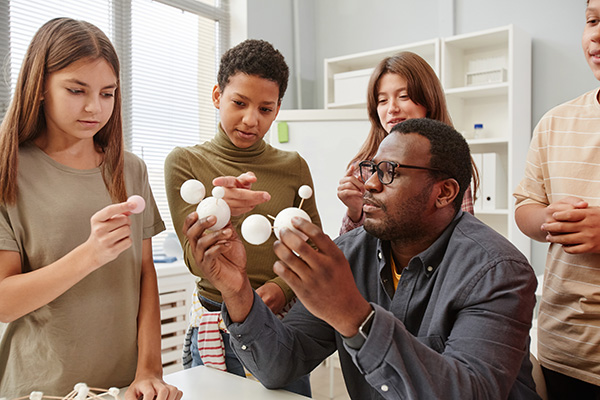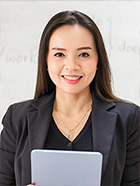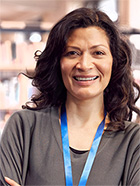How can educators identify and address potential barriers when designing instruction?
Page 6: Methods
 Educators use a variety of instructional methods every day. Methods refer to the ways in which the content is taught to help students reach the learning goal. Educators must be proactive in removing barriers from instructional methods to help ensure access and agency for all. When educators utilize methods that incorporate flexible options, students can make choices about how they learn and pursue the goal.
Educators use a variety of instructional methods every day. Methods refer to the ways in which the content is taught to help students reach the learning goal. Educators must be proactive in removing barriers from instructional methods to help ensure access and agency for all. When educators utilize methods that incorporate flexible options, students can make choices about how they learn and pursue the goal.
Educators who understand UDL know that no single method works for every learner. Therefore, educators should use a variety of evidence-based and effective methods to design multiple means of engagement, representation, and action and expression. They can do this by adapting and combining multiple methods to address their learners’ variability.
The six common instructional methods listed below each exhibit strengths and potential barriers to learning, but educators can address these barriers using strategies aligned with the UDL principles. As you review these, keep in mind that different instructional methods serve different purposes and may look different in different grades, content areas, and cultural contexts, but every method can be designed and implemented using UDL.
Teacher-directed instruction, an instructional method in which the educator is the primary deliverer of instruction, usually involves practices like lecturing, modeling, and explicit instruction. Although this method allows the educator to communicate information to a group, teacher-directed instruction can pose challenges if educators do not address potential barriers such as those related to student engagement and comprehension. Educators can better align teacher-directed instruction with UDL by:
modeling
The act of providing an example as a means through which to encourage the imitation of a skill, process, characteristic, or style.
explicit instruction
An instructional approach in which teachers clearly identify the expectations for learning, highlight important details of the concept or skill, offer precise instruction, and connect new learning to earlier lessons and materials.
- Making purposeful connections to students’ interests and experiences
- Using strategies to activate background knowledge (e.g., advance organizers, KWL chart)
x
advance organizer
A preview or organizational guide used to acquaint students with the content, structure, or importance of written material or a lecture.
xKWL chart
A type of graphic organizer used to indicate what students know about a topic, what they want to know, and what they have learned. The first two columns are filled in before engaging with the content, and the last column is filled in as the student progresses through the lesson or unit (e.g., added to column at the end of each day) or at the end of the unit.
- Restructuring lengthy lectures into mini lectures of 10-15 minutes interspersed with active learning activities
- Providing guided notes
x
guided notes
A strategic note-taking method in which teachers provide an outline of the main ideas and related concepts being taught with blanks inserted for students to write key words or information as they are presented.
- Recording key ideas on an interactive whiteboard
- Using think alouds to verbalize thought processes while modeling
Asking questions of the class or individual students can help students commit content to memory, stimulate discussion, and serve as a type of formative assessment. Questioning can increase student engagement and promote expression. However, barriers can appear if educators do not address demands, such as those related to prior knowledge, language, and oral communication. Educators can better align questioning with UDL by:
- Asking questions at a variety of cognitive levels, from basic factual recall (e.g., who, what, where, when) to more inferential (e.g., why, how)
- Allowing adequate wait time between asking a question and expecting a response
- Providing non-verbal options for answering questions (e.g., gesturing, using technology, response cards)
x
response cards
Cards, signs, or items that are simultaneously held up by all students to display their response to a question or problem presented by the teacher.
- Using prompting to assist students in reaching the correct answer
x
prompting
An instructional strategy in which any one of a number of different cues (e.g., gestures, illustrations or photographs, modeling) is used to help a student to learn a new skill or behavior.
- Giving frequent, timely, and constructive feedback
When students are invited to practice previously learned skills independently, they move new information from working memory into long-term memory. Independent practice may be accomplished through activities (e.g., worksheets, written assignments, hands-on activities) that are directly connected to recent learning experiences. Although independent practice can support students’ understanding and retention of content, students can also encounter barriers to their learning. For example, barriers may occur if educators assume that all learners possess needed background knowledge or if they fail to provide constructive feedback. Educators can better align independent practice with UDL by:
working memory
The type of memory that allows a person to hold information while completing a task (e.g., following directions, comprehending text, solving a mathematics problem).
- Offering different types of practice activities
- Pre-teaching critical prerequisite skills needed to complete the independent activity (e.g., choosing materials, asking for help, following directions)
- Using scaffolded instruction to provide supports that can be gradually phased out as students become more independent with the skill
x
scaffolded instruction
A process in which a teacher adds supports for students to enhance learning and aid in the mastery of new skills and then gradually removes the supports as the students master the skill.
- Giving frequent, timely, and constructive feedback
- Asking questions to guide students’ self-monitoring and reflection
Educators may have their students engage in discussions about content, its applications, or their own perspectives. Discussions may occur with the whole class, in small groups, or in pairs. When facilitated well, group discussions can be very engaging for many students. However, they can also be inaccessible to some learners if educators do not address potential barriers, such as social and auditory processing demands. Educators can better align their discussions with UDL by:
- Establishing and teaching class routines for discussions
- Structuring discussions through pre-assigned or posted prompts
- Prioritizing discussions around authentic and relevant content
- Clarifying students’ statements using examples and analogies
- Recording key concepts on a physical or interactive whiteboard throughout discussions
- Offering virtual options for discussions (e.g., forums, video-based discussions)
Cooperative learning is an instructional method in which students work together in heterogeneous, or mixed-ability, small groups. This teaching strategy is associated with increased student motivation, positive social interaction, and improved academic performance. Nevertheless, barriers may be present when, for example, educators do not create groups intentionally or provide clear structure and expectations for group work. Educators can better align cooperative learning with UDL by:
- Creating an accepting and supportive classroom culture
- Establishing explicit roles and responsibilities for each group member (e.g., facilitator, recorder, timekeeper, reporter)
- Using flexible groupings that change often based on considerations, such as student interest or activity type
- Developing clear expectations for group work using rubrics or checklists
- Encouraging reflection on both group and individual performance
Project-based learning is a student-centered instructional method in which students learn by actively engaging in projects that address complex, real-world, and personally meaningful questions or problems over an extended period of time. This strategy can be highly motivating and allows for the integration of authentic content, but barriers may exist if educators do not address requirements, such as those related to executive function and generalization skills. Educators can better align their project-based learning with UDL by:
generalization
The transfer of learned information from a particular instance to other environments, people, times, and events.
- Designing projects that address relevant and timely situations
- Integrating opportunities for students to communicate to real audiences
- Making explicit cross-curricular connections among concepts and skills
- Chunking the project into smaller component parts or steps
- Supplying checklists or templates to support project planning, prioritizing, and sequencing
- Providing varied tools for communication, collaboration, and composition of the project
Keep in Mind
As educators plan instructional methods using a UDL lens, they should ask themselves the following questions:
- How will I offer flexible options for learners to work toward the goal?
- Are all of the options I provide accessible to all learners, or do they create barriers for some?
- How do my instructional methods foster collaboration and interdependence?
- How will I optimize the available choices to avoid overwhelming students with too many options?
These questions have been adapted from the following handout.
Activity
Mr. Hughes, Ms. Tong, and Mrs. Rios—having learned about UDL—now understand the importance of using instructional methods that incorporate flexible options to allow students multiple ways to engage and reach the learning goal. Below, consider how you would address the barriers in their methods and then discover how the educators intend to do so.

Mr. Hughes
Elementary mathematics lesson goal:
Students will represent numerical data on a bar graph and use the graph to answer questions.
In previous years, Mr. Hughes has used the following instructional methods:
- Teacher-directed instruction focused on modeling simple bar graphs on an interactive whiteboard
- Cooperative learning to practice graphing a fictional data set in small groups
- Independent practice answering questions on a worksheet
Reflect on the following:
- What potential barriers do you recognize in these methods?
- How can Mr. Hughes revise his methods to be more universally designed?
You may choose to reflect on these questions in a variety of ways, such as jotting down some notes, drawing a picture, or discussing with your colleagues. The fields below are available as options to record your thoughts.
Note: These fields are provided for reflection purposes only; your answers will not be available for downloading or printing.
Enter text here
Draw here using your cursor or finger

After you have generated your own ideas, learn how Mr. Hughes intends to address the barriers in his methods (time: 0:47).
Transcript: Mr. Hughes
I’ve definitely got some barriers to engagement and action and expression happening here. The things that I model and have the students graph really aren’t very interesting or connected to their lives at all. I bet they would be a lot more engaged if they chose what to graph—I could even let them poll each other and graph that data. The small groups are always a challenge because I inevitably have at least one or two groups where one student does all the work. I should set those groups up with more structure and group roles. The social part of group work is a barrier for some of my students who have social anxiety or autism, so I could assign them a role that plays to their strengths. That worksheet becomes a barrier for a lot of the students, too. It’s only one way to show what they’ve learned, and I could make that activity more interactive or authentic.

Ms. Tong
Middle school language arts unit goal:
Students will be able to identify a theme in a grade-level piece of fiction and locate supporting details in the text.
In previous years, Ms. Tong has used the following methods:
- Independent practice identifying themes as homework
- Unstructured discussion among the whole class
Reflect on the following:
- What potential barriers do you recognize in these methods?
- How can Ms. Tong revise her methods to be more universally designed?
You may choose to reflect on these questions in a variety of ways, such as jotting down some notes, drawing a picture, or discussing with your colleagues. The fields below are available as options to record your thoughts.
Note: These fields are provided for reflection purposes only; your answers will not be available for downloading or printing.
Enter text here
Draw here using your cursor or finger

After you have generated your own ideas, learn how Ms. Tong intends to address the barriers in her methods (time: 1:03).
Transcript: Ms. Tong
There’s not much variety in my methods, is there? The discussion seems like the easiest thing to address. Instead of always having everyone discuss together, I could switch it up by having small groups focus on a particular theme and share out, and I could use some think-pair-share activities. I’m sure that would increase engagement and keep it from always being the same few students who speak up. I think the independent practice is important for middle schoolers, but I probably tend to assume that they have the background knowledge and executive functioning skills they need to do that. I could start the unit with a KWL chart on theme and then do a mini-lecture to highlight the key elements they need to understand. Also, it would probably be helpful to provide a scaffold, like some guiding questions to refer to while they’re reading at home. Those could help them figure out the themes, and we could use them to guide class discussion the next day, too.

Mrs. Rios
High school biology lesson goal:
Students will be able to model and explain the process of mitosis.
In previous years, Mrs. Rios has used the following methods:
- Teacher-directed instruction involving lecture and slides while students take two-column notes
- Questioning students about vocabulary and discrete steps in the process with individual students responding when called on
- Independent practice, which consists of reading the textbook and drawing the cell cycle
Reflect on the following:
- What potential barriers do you recognize in these methods?
- How can Mrs. Rios revise her methods to be more universally designed?
You may choose to reflect on these questions in a variety of ways, such as jotting down some notes, drawing a picture, or discussing with your colleagues. The fields below are available as options to record your thoughts.
Note: These fields are provided for reflection purposes only; your answers will not be available for downloading or printing.
Enter text here
Draw here using your cursor or finger

After you have generated your own ideas, learn how Mrs. Rios intends to address the barriers in her methods (time: 1:06).
Transcript: Ms. Rios
I’ve known for a while that I lecture too much, but UDL has made it even more clear that I need to change that. Instead of talking for half of the class, I could break the content up into a few mini-lectures on key points and even embed more hands-on activities and discussion. Also, I’ve noticed that the two-column notes don’t work for everyone either. There are other note-taking strategies that I don’t think my students even know about. I could take some time to introduce those in class, and students can figure out what works best for their own learning. And the questioning would be much more engaging if everyone could be involved, not just those who always raise their hands to answer. We could maybe use response cards or even an online trivia game. And I like that the independent activity helps my students practice with the concepts on their own. But I really do have a bad habit of just sitting at my desk while they do that part. I need to make sure I’m really giving constructive feedback while they’re doing independent practice, to help them make connections and correct any misconceptions right on the spot.
